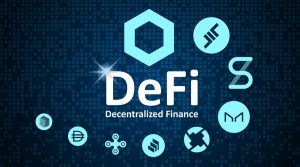The financial industry is undergoing a significant transformation with the rise of decentralized finance, commonly known as DeFi. One of the most revolutionary aspects of DeFi is lending, which has the potential to disrupt traditional lending practices and provide new opportunities for individuals and businesses around the world. In this article, we will explore the rise of DeFi lending and how it is reshaping the financial landscape.
Introduction to DeFi Lending
To understand the concept of Decentralized Finance lending let’s first clarify what DeFi is. DeFi refers to a decentralized financial system that operates on blockchain technology and smart contracts, eliminating the need for intermediaries such as banks or other financial institutions. In the traditional financial system, lending involves borrowing funds from a centralized authority, such as a bank, which controls the terms and conditions of the loan. Decentralized Finance lending, on the other hand, allows individuals to lend and borrow funds directly from each other through decentralized platforms.
Understanding Decentralized Finance (DeFi)
DeFi is built on the principles of openness, transparency, and accessibility. By leveraging blockchain technology, DeFi platforms enable secure and trustless transactions without relying on intermediaries. This eliminates the need for complex paperwork, lengthy approval processes, and geographical limitations that often exist in traditional finance. DeFi offers several advantages over traditional finance, including faster transactions, lower fees, and increased financial inclusivity.
Smart contracts, which are self-executing agreements with predefined rules encoded on the blockchain, play a crucial role in DeFi. They automate various financial processes, including lending, by ensuring that transactions occur only when specific conditions are met. Smart contracts facilitate transparency, reduce the risk of fraud, and enable efficient lending operations in the DeFi ecosystem.
The Emergence of DeFi Lending
Decentralized Finance lending has gained traction in recent years, with the development of dedicated platforms and protocols. These platforms allow users to lend and borrow digital assets in a peer-to-peer manner, creating a decentralized lending marketplace. One of the key features of Decentralized Finance lending is the ability to earn interest on deposited assets or borrow against them.
Compared to traditional lending, Decentralized Finance lending offers several advantages. First, it eliminates the need for intermediaries, making the lending process more efficient and cost-effective. Second, Decentralized Finance lending platforms often provide higher interest rates for lenders and lower interest rates for borrowers, thanks to the absence of intermediaries and lower operational costs. Additionally, DeFi lending enables individuals to access financial services regardless of their location or credit history, promoting financial inclusivity on a global scale.
How DeFi Lending Works?
DeFi lending operates through a series of interconnected protocols and smart contracts. To participate in DeFi lending, users deposit their digital assets into a lending platform’s smart contract, which acts as a decentralized pool of funds. Borrowers can then request loans by providing sufficient collateral. The collateralization ensures that lenders are protected in case of default.
Overcollateralization is a common practice in DeFi lending, meaning borrowers must provide more collateral than the value of the loan they are requesting. This mitigates the risk for lenders and ensures the stability of the lending platform. Once the loan is repaid, borrowers receive their collateral back.
Automated liquidity provision is another crucial aspect of DeFi lending. Liquidity providers contribute their assets to decentralized liquidity pools, which are used to match borrowers with lenders. This process facilitates efficient borrowing and lending by ensuring there is always sufficient liquidity available.
Yield farming and staking are additional mechanisms used in DeFi lending to incentivize participants. Lenders and borrowers can earn additional rewards or interest by staking their assets or participating in yield farming strategies, which involve providing liquidity to specific pools or protocols.
Advantages of DeFi Lending

- Accessibility: These platforms are accessible to anyone with an internet connection and a digital wallet. There are no geographical restrictions or barriers based on credit history. This inclusivity allows individuals from all around the world to participate and access financial services that were previously out of reach.
- Global Reach: It operates on blockchain technology, which enables borderless transactions. Unlike traditional lending that often involves complex cross-border transfers and associated fees, Decentralized Finance lending allows users to lend and borrow funds globally without intermediaries. This not only reduces costs but also enhances financial connectivity and fosters global economic integration.
- Higher Interest Rates: These platforms often offer higher interest rates compared to traditional savings accounts or investment options. Lenders can earn passive income by providing liquidity to the platforms, maximizing their yield potential. This can be particularly appealing for individuals seeking better returns on their idle assets.
- Enhanced Privacy and Security: It prioritizes privacy and security. Instead of relying on centralized institutions that may collect and store sensitive financial information, Decentralized Finance lending platforms operate on the principles of anonymity and pseudonymity. Users retain control over their funds and personal data, reducing the risk of data breaches or identity theft.
- Efficiency and Automation: DeFi lending leverages smart contracts, which are self-executing agreements with predefined rules encoded on the blockchain. These contracts automate various financial processes, including lending, by ensuring that transactions occur only when specific conditions are met. This automation reduces the need for intermediaries, streamlines the lending process, and eliminates paperwork, resulting in faster and more efficient transactions.
Risks and Challenges in DeFi Lending
Let’s explore some of the key risks and challenges in DeFi lending:
- Smart Contract Vulnerabilities: Smart contracts are at the core of DeFi lending platforms. They are coded by humans and can contain bugs or vulnerabilities. Exploiting these vulnerabilities can lead to potential financial losses or security breaches. Thorough audits and due diligence are necessary to minimize the risk of smart contract vulnerabilities.
- Market Volatility: DeFi lending relies on digital assets as collateral. The value of these assets can be highly volatile, leading to potential undercollateralization or liquidation events. Market fluctuations can result in borrowers not being able to repay their loans, affecting lenders’ funds. Managing exposure to market volatility is crucial when participating in DeFi lending.
- Regulatory Uncertainty: The regulatory landscape around Decentralized Finance lending is still evolving. Different jurisdictions may have different approaches and regulations concerning cryptocurrencies and decentralized finance. The lack of clear regulatory frameworks can create uncertainty and compliance challenges for Decentralized Finance lending platforms and participants.
- Lack of Insurance: Unlike traditional banking, where deposits are often insured by government-backed schemes, Decentralized Finance lending platforms generally do not offer the same level of insurance protection. This means that if a platform is hacked or experiences a security breach, there may be limited recourse for users to recover their funds.
- User Error and Hacks: These platforms require users to manage their digital assets and interact with smart contracts directly. User error, such as sending funds to the wrong address or incorrectly interacting with smart contracts, can lead to irreversible loss of funds. Additionally, the risk of hacking and phishing attacks targeting users’ wallets or private keys is a constant concern in the DeFi space.
DeFi Lending Use Cases
DeFi lending unlocks a wide range of use cases and opportunities. Borrowers can utilize DeFi loans for various purposes, including leveraging their digital assets to access additional capital without selling them. This is particularly useful for individuals who believe in the long-term value of their assets but need liquidity in the short term.
Yield optimization strategies are another popular use case in Decentralized Finance lending. By providing liquidity to specific protocols or participating in yield farming, individuals can earn additional rewards in the form of governance tokens or interest-bearing tokens. These strategies allow participants to maximize their returns on idle assets.
Furthermore, DeFi lending promotes capital efficiency and financial innovations. It enables the creation of new financial products and services that were previously inaccessible or uneconomical in the traditional financial system. These innovations range from decentralized stablecoins and synthetic assets to decentralized derivatives and insurance products.
The Impact of DeFi Lending on the Financial Industry
DeFi lending has the potential to significantly impact the financial industry. It introduces the concept of disintermediation, bypassing traditional intermediaries such as banks and lending institutions. Instead, lending occurs directly between peers, reducing costs, and increasing efficiency. This disintermediation democratizes access to financial services, empowering individuals who were previously excluded from the traditional banking system.
DeFi lending also challenges the traditional role of banks and financial institutions. With decentralized lending platforms gaining popularity, banks may need to adapt their business models to remain competitive. They may explore partnerships with DeFi platforms or integrate DeFi lending into their existing services to provide a seamless experience for their customers.
Future Outlook and Adoption of DeFi Lending
The future of DeFi lending looks promising. The industry has experienced rapid growth, with billions of dollars locked in DeFi protocols and an increasing number of users participating in lending and borrowing activities. Institutional interest in DeFi is also on the rise, with major financial institutions exploring opportunities in this space.
Mainstream adoption of Decentralized Finance lending will likely depend on regulatory developments. As regulators work to establish frameworks that balance innovation and consumer protection, DeFi lending platforms will need to navigate compliance requirements to gain trust and confidence from a broader audience.
Conclusion
Decentralized Finance lending is revolutionizing the financial industry by offering a decentralized, inclusive, and efficient alternative to traditional lending practices. With its advantages in accessibility, global reach, higher interest rates, and enhanced privacy, DeFi lending is a game changer that has the potential to reshape the way we borrow and lend funds. As the industry continues to evolve, it is crucial for individuals and businesses to stay informed and adapt to this transformative financial landscape.
FAQs
Is DeFi lending safe?
While DeFi lending presents opportunities, it also comes with risks. Smart contract vulnerabilities and market volatility are potential risks to be aware of. It is essential to conduct thorough research, review audits, and use reputable platforms to mitigate these risks.
How can I start participating in DeFi lending?
To participate in DeFi lending, you need a digital wallet and access to a decentralized lending platform. You can research and choose a platform that aligns with your needs, deposit your assets into the platform’s smart contract, and either lend or borrow funds based on the available options.
Are the interest rates in DeFi lending higher than traditional banking?
Yes, Decentralized Finance lending often offers higher interest rates compared to traditional banking. However, it’s important to consider the risks associated with lending in a decentralized and volatile environment.
Can I use any digital asset as collateral for DeFi loans?
The eligibility of assets as collateral depends on the lending platform and its specific requirements. Popular cryptocurrencies like Bitcoin and Ethereum are widely accepted, but platforms may have limitations or specific criteria for collateral options.
What is the role of smart contracts in DeFi lending?
Smart contracts automate the lending process in , Decentralized Finance. They define the terms and conditions of the loans, facilitate collateralization, and ensure that transactions occur only when predefined conditions are met. Smart contracts enhance transparency, security, and efficiency in DeFi lending.






